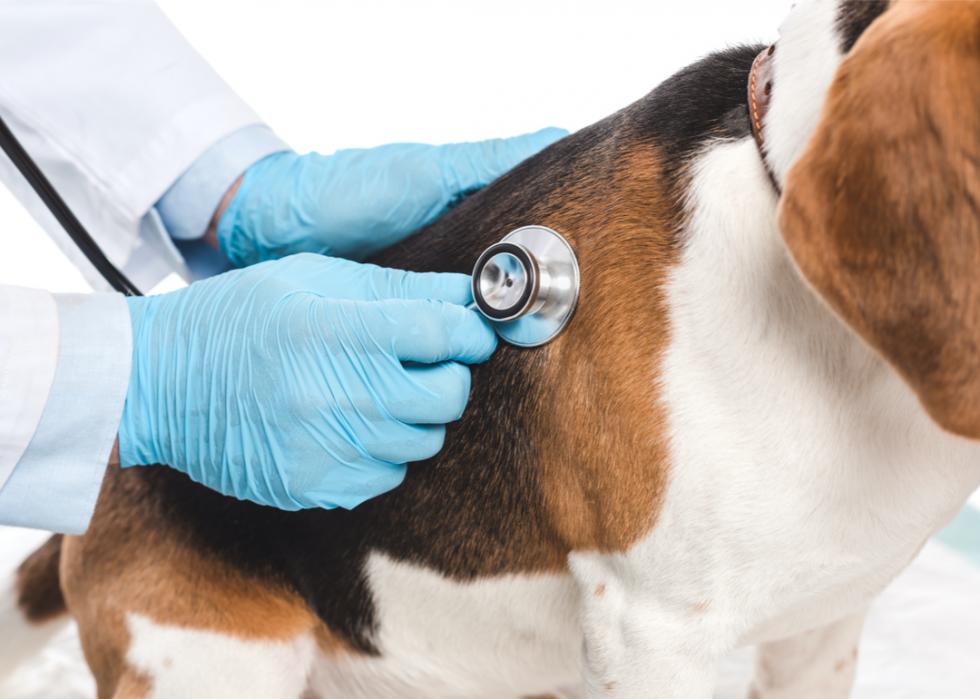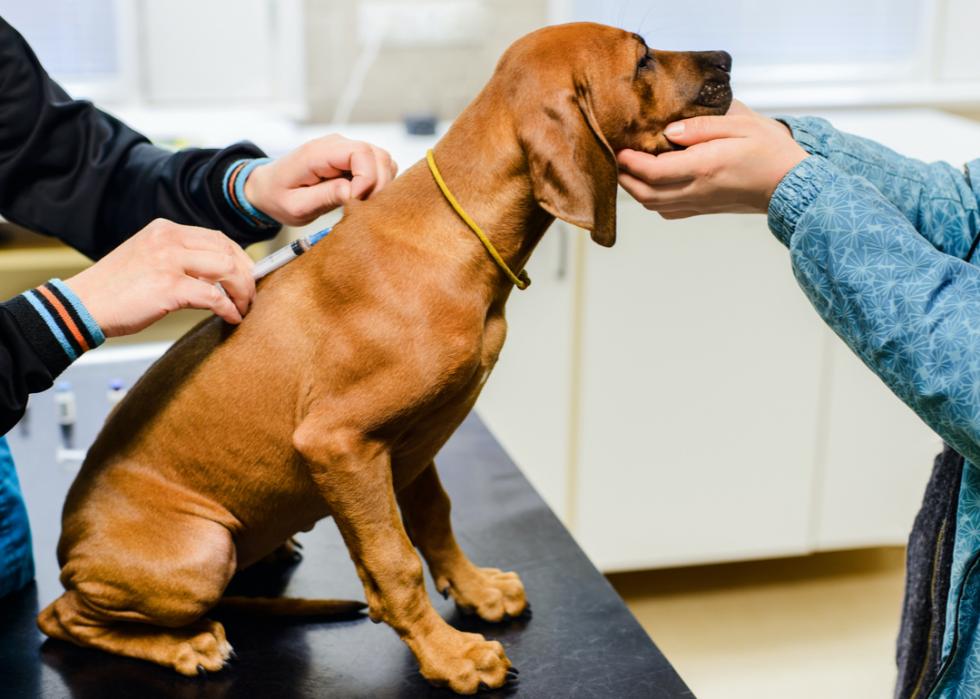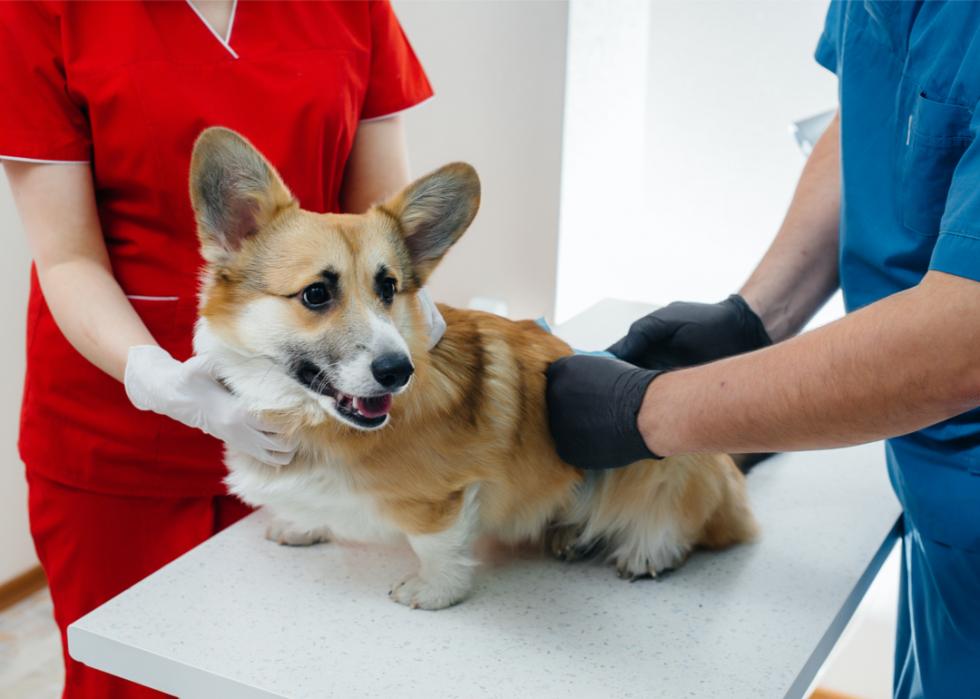
How to prevent parasites, parvovirus, and other common illnesses affecting dogs
This story originally appeared on Nom Nom and was produced and distributed in partnership with Stacker Studio.
How to prevent parasites, parvovirus, and other common illnesses affecting dogs
Dogs have been our most faithful and loyal companions for ages. They have become so ingrained in human life that they are considered by many to be family members.
Over the past few decades, dogs have become an even greater part of our lives. We send them to doggie daycare for socialization and entertainment and training classes for agility and obedience. We allow them to sleep on couches and in beds, take them to dog parks, and provide them with delicious and nutritious food. We care as much about their health and happiness as we do our own. To best care for our dogs, it is important that we keep an eye on their health.
Nom Nom compiled a list of 15 common illnesses affecting dogs using data from pet organizations and veterinarians including the American Kennel Club (AKC), the Centers for Disease Control (CDC), the American College of Veterinary Surgeons (ACVS), and the American Veterinary Medical Association (AVMA).
We've covered everything from the relatively new illness to hit canines, one that humans have been battling forever, and another that represents one of the most common and preventable afflictions. We touch on many of the health concerns that affect dog owners and their loving furry pals and provide a description of the ailment, a list of symptoms, and what you should do to prevent and/or treat the most common illnesses affecting dogs.
Settle in with Fido and join us to find out the 15 most common illnesses affecting man's best friend.

Canine influenza
While humans have been dealing with the flu for ages, influenza is relatively new to dogs, which means canine immune systems do not know how to respond to the disease. Canine influenza is spread through respiratory secretions and contaminated objects, and symptoms include a runny nose, cough, and fever. While there is a vaccine, it is best to speak with a veterinarian as it is not recommended for all dogs and care includes rest, extra fluids, and nonsteroidal anti-inflammatory medications to reduce fever.

External parasites
Oftentimes, dogs—especially during warmer months—pick up ticks, fleas, mange, and Cheyletiella mites, which causes what looks like dandruff on the trunk. These parasites are picked up from the environment as well as exposure to other dogs and can bring with them a host of other issues including diseases, worms, and home and human infestation in the case of fleas and mites. There are a number of products out there that can safely prevent and treat these parasites.

Kennel cough
This common dog illness is often seen in animals who are boarded or go to doggie daycare and with other dogs that transmit the respiratory disease. A dog can be sick with kennel cough well before they show symptoms, which include a runny nose and a hacking, nonproductive cough. Depending on the severity of the illness, treatment may include rest or a prescribed antibiotic, though there is a vaccine to prevent kennel cough.

Diabetes
Dogs can develop either Type 1 or Type 2 diabetes, though Type 1 is more common. The disease is caused either by a lack of insulin production or impaired insulin production and n inadequate insulin response. Symptoms include excessive thirst, weight loss, increased urination, and lethargy, and there is an increased risk for certain breeds as well as obese dogs. Many diabetic dogs require insulin injections, and it is important to maintain a regular feeding schedule and coordinate feeding and medication times.

Parvovirus
This highly contagious virus is caused by the canine parvovirus type 2 and attacks the gastrointestinal system. It is transmitted via contact with other dogs and contaminated stool and objects like leashes and bowls and can survive for years in the soil. Symptoms include fever, vomiting, and bloody diarrhea, and treatment often doesn't work, which is why vaccination against parvo is recommended for all dogs.

Rabies
Once animals begin to show signs of rabies, which is caused by the rabies virus, it is 100% fatal. The virus is spread through saliva and can be passed through the bite of an infected animal. The most effective way to prevent rabies is through vaccination, and many states require rabies vaccinations for all dogs.

Periodontal disease
Periodontal disease, also known as gum disease is much more common in dogs than it is in humans. Gum disease is difficult to detect because there are often no symptoms until it is more advanced, at which point symptoms may include loose teeth, bleeding gums, and chewing food on one side of the mouth. Dogs with gum disease are at a higher risk for liver, heart, and kidney disease. Brushing teeth twice a day, providing regular dental cleanings, and feeding a healthy diet remain the best methods of prevention.

Ear infections
Dogs often spend a significant amount of time outdoors and exposure to dirt and dust can cause ear infections. One of the main signs of a dog battling an ear infection is that they will paw at their ears or tilt or shake their head. Prevention may help and properly cleaning dogs' ears is important though once an infection occurs treatment usually requires an antibiotic administered by a vet.

Heatstroke
The risk of dogs overheating in the summer is high because dogs are covered in fur and do not respond to heat by sweating as humans do, and certain breeds are known as brachycephalic (flat-faced) dogs are especially prone to heatstroke. Keeping dogs in cool areas, providing plenty of water, and never leaving them in cars can prevent heatstroke. If a dog displays any of the following signs, including drooling, weakness, abnormal gum color, and excessive panting, they should be moved to a cool shaded area and treated with cold wet towels and a trip to a local vet.

Obesity
Prevalent not just in humans, obesity plagues dogs as well—especially in the United States. According to the Association for Pet Obesity Prevention and a 2018 clinical survey, 36.9% of dogs are classified as overweight, while 18.9% of dogs were considered obese. Obesity can impact overall health including Type 2 diabetes and osteoarthritis and can be managed with meal measurement, limiting treats, and providing your dog with more opportunities for exercise.

Tickborne diseases
Ticks spread many different diseases to dogs including Lyme disease, tularemia, ehrlichiosis, babesiosis, and many others. Many tickborne diseases are specific to certain parts of the U.S. and symptoms may include lameness, weakness, lethargy, and anemia. While there is a Lyme vaccine, preventing tick bites by carefully checking for ticks after dogs venture outside and removing them once they are discovered is vital.

Intestinal parasites
There are many intestinal parasites common to dogs including tapeworm, roundworm, hookworm, and ringworms. Dogs with worms often scoot on their bottom, lose weight, have what looks like grains of rice in their stool, and diarrhea that may be bloody. A dog should be seen by a vet for worms to determine what type of internal parasite the dog has and provide the proper medication.

Arthritis
The most common form of arthritis in dogs is osteoarthritis and it is estimated to affect a quarter of the population. Signs include a decrease in activity, lameness, gait changes, and the inability to jump. Weight control, therapeutic exercises to help with joint mobility, joint supplements, and Nonsteroidal anti-inflammatory drugs all help manage arthritis in our furry friends.

Hot spots
Acute moist dermatitis, more commonly known as hot spots are bare, red areas that are a common skin condition for dogs. The location of the hot spot can help determine its cause. Treatment can range from topical medications to antibiotics depending on the severity of the hot spots.

Heartworm
Infected mosquitoes can infect dogs with heartworm when they bite them, and the worms enter the dog's bloodstream. The worms then grow in the dog's heart, which causes inflammation and forces the heart to work harder. Often there are no clinical symptoms, and worms are only found at a vet screening, at which time treatment is expensive and taxing on the dog, so prevention is preferable.



